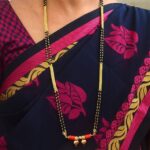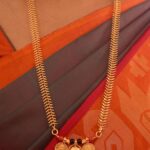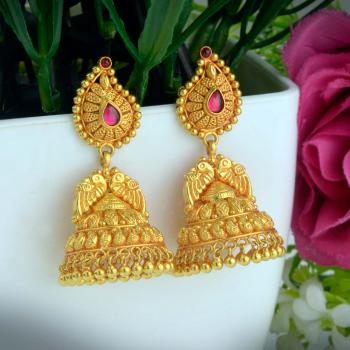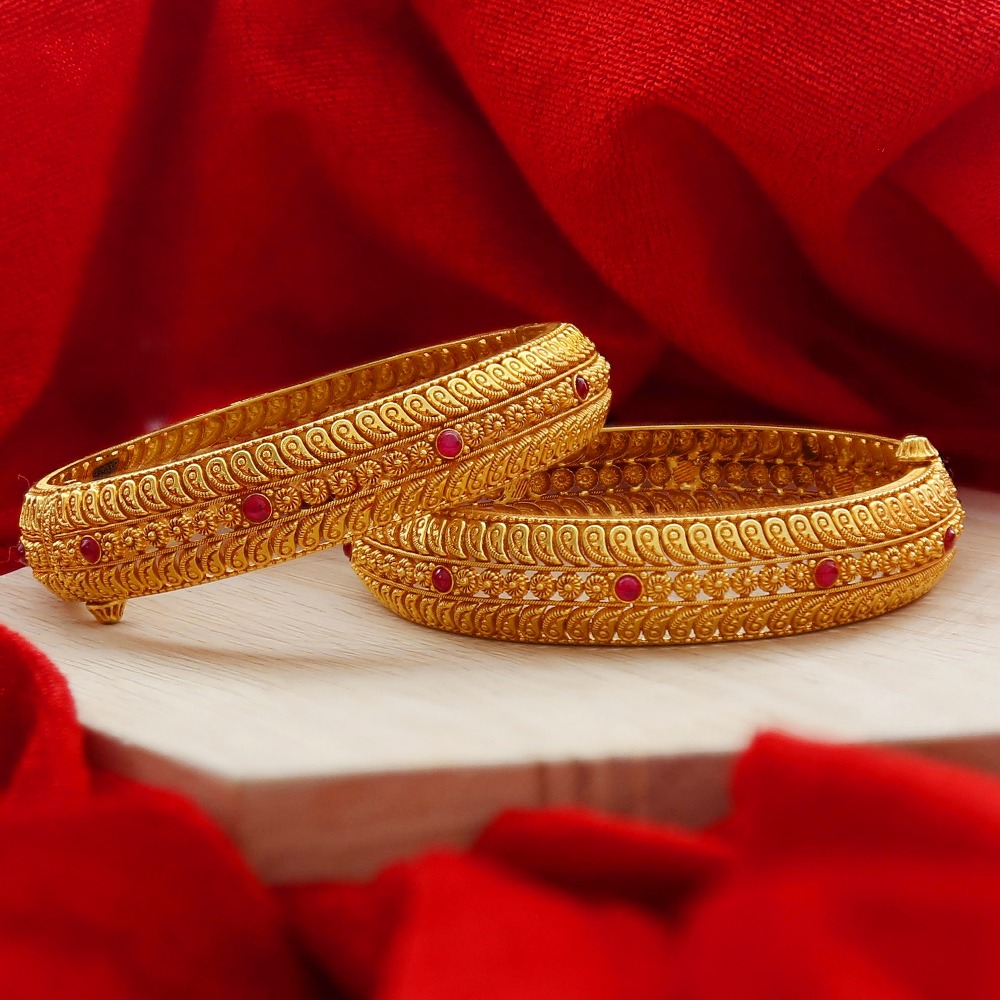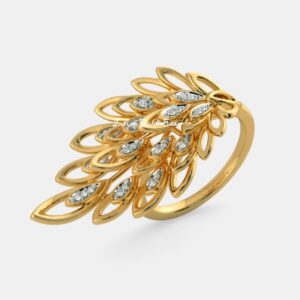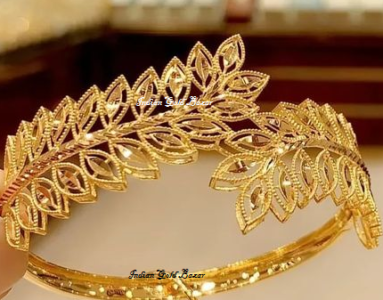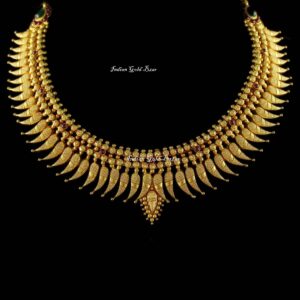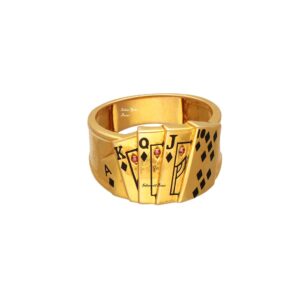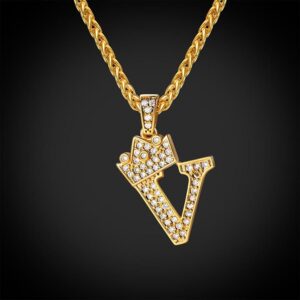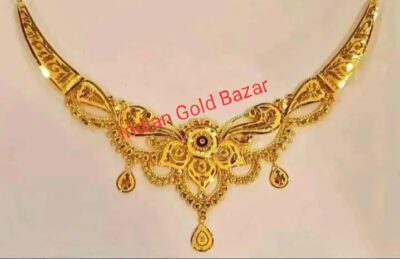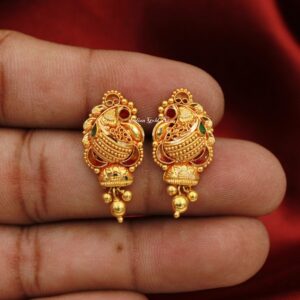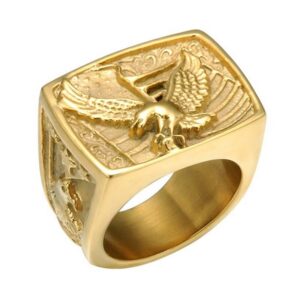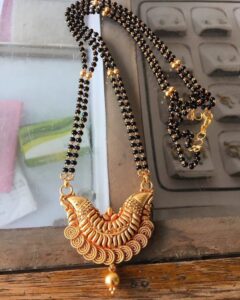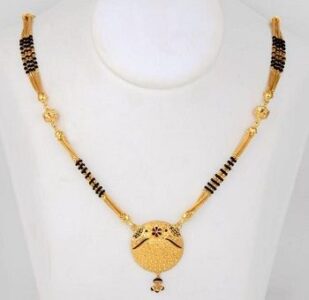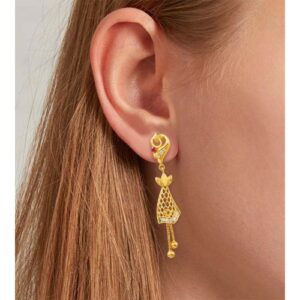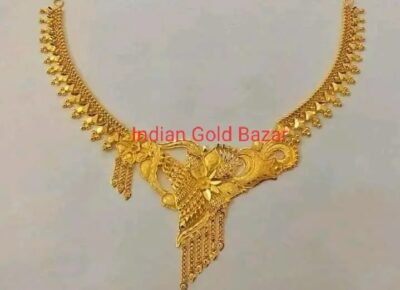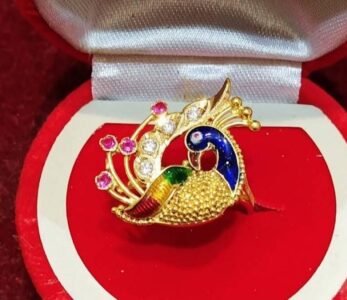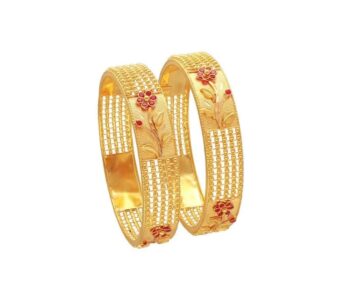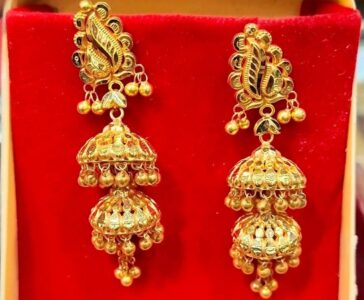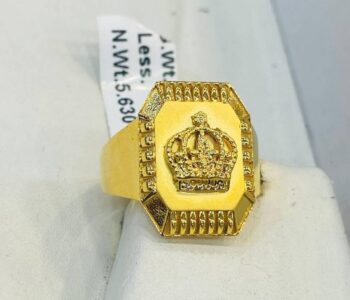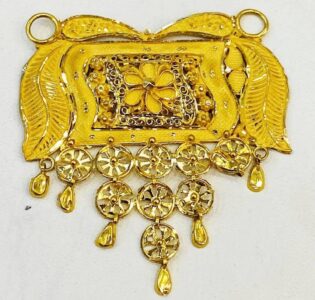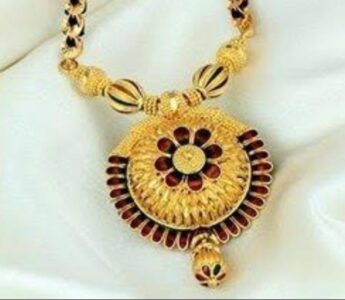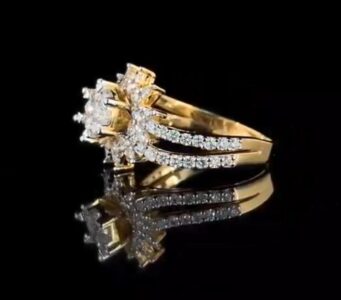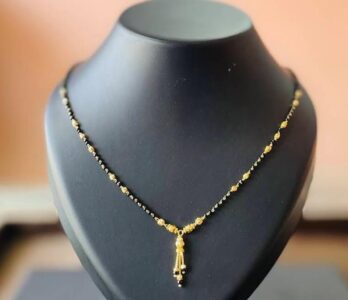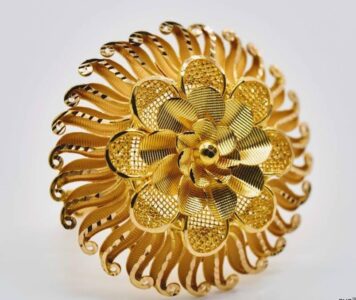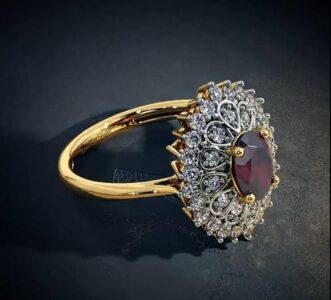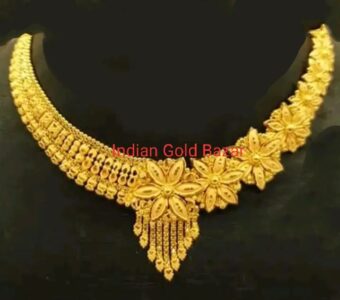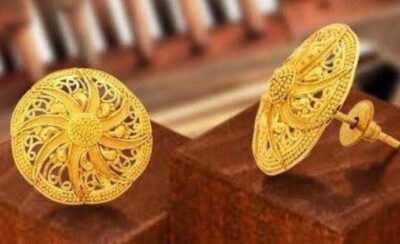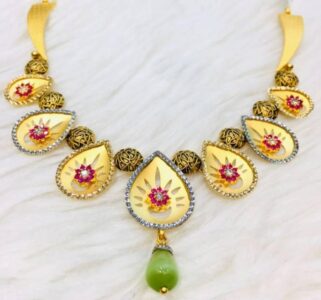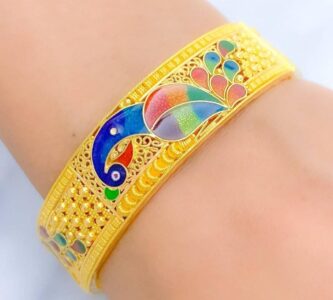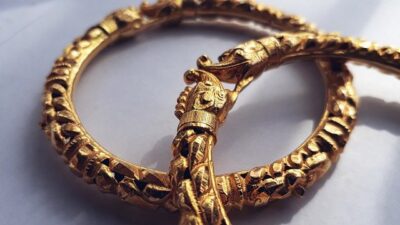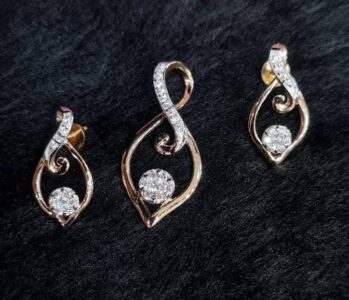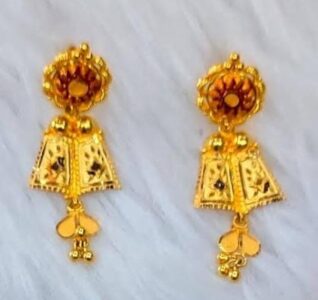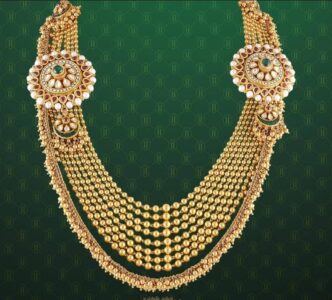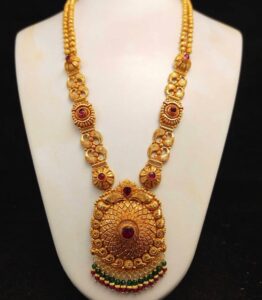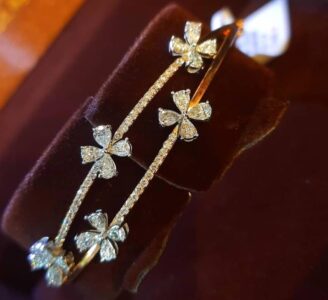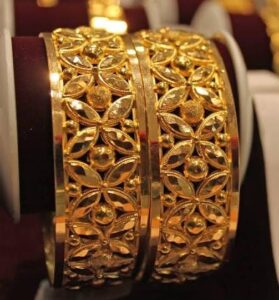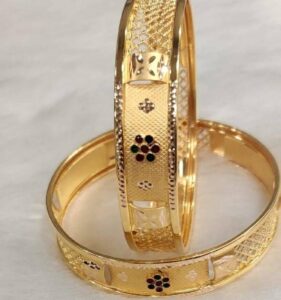Home >>Mangalsutra Design Page >>Mangalsutra Blog
Modern Mangalsutra >> Trending Mangalsutra >> Traditional Mangalsutra
Mangalsutra
The Mangalsutra holds significant cultural and symbolic importance in Hindu marriages, particularly in India. It's a sacred necklace or pendant worn by married women as a symbol of their marital status and the bond between husband and wife. The design and significance can vary based on regional customs and personal preferences. Typically, it consists of black beads strung together on a gold chain with a central pendant. The black beads are believed to protect the couple from evil spirits, while the gold represents prosperity and auspiciousness. The groom typically ties the Mangalsutra around the bride's neck during the wedding ceremony as a symbol of their union and commitment.
Why Mangalsutra Important
The Mangalsutra holds immense significance in Hindu culture and marriages for several reasons:
Symbol of Marriage: It symbolizes the sacred union between a husband and wife. It's not just a piece of jewelry but a representation of the lifelong commitment and love between the couple.
Cultural Tradition: It's deeply rooted in Indian tradition and is considered an essential part of a married woman's attire. It signifies her marital status and is often worn as a mark of respect for the institution of marriage.
Spiritual and Symbolic Meaning: The black beads in the Mangalsutra are believed to have protective and auspicious qualities. They are thought to ward off negative energies and protect the couple's relationship from any harm or evil.
Emotional Significance: It's not just a piece of jewelry; it holds sentimental value. It's often passed down through generations, carrying with it the blessings and legacy of previous generations within the family.
Social Recognition: In many communities, the presence of the Mangalsutra signifies that a woman is married, which helps in social recognition and respect within the community.
Traditional Customs: In Hindu weddings, the ritual of tying the Mangalsutra is considered one of the most important rituals. It's a momentous occasion symbolizing the formal acceptance of the marital bond.
Overall, the Mangalsutra isn't just a piece of jewelry; it embodies cultural, emotional, and spiritual significance, representing the sacred bond between a husband and wife in Hindu marriages.
Why Mangalsutra Important in Marriage
The Mangalsutra holds deep importance in Hindu marriages for several reasons:
Symbol of Union: It symbolizes the eternal bond and commitment between husband and wife. Its significance lies in representing the union, love, and togetherness of the couple.
Spiritual Significance: The Mangalsutra is believed to have spiritual and protective qualities. The black beads, often strung together with gold, are thought to ward off negative energies and bring prosperity and well-being to the married couple.
Cultural Traditions: It's an integral part of Hindu customs and traditions. Its presence signifies adherence to cultural norms and rituals associated with marriage, representing the sanctity of the marital relationship.
Blessings and Heritage: It often carries family heritage and blessings. Many Mangalsutras are passed down through generations, representing the family's history, blessings, and the continuation of traditions.
Social Recognition: Wearing the Mangalsutra is a societal acknowledgment of a woman's marital status. In many communities, it serves as a visible symbol that she is married and holds a respected place within society.
Ritual of Tying: During the wedding ceremony, the groom ties the Mangalsutra around the bride's neck, signifying the formal acceptance of the marital relationship in front of family and witnesses.
Emotional Value: Beyond its symbolic and material significance, the Mangalsutra holds emotional value. It's often cherished by married women as a token of their relationship and the vows exchanged during marriage.
In essence, the Mangalsutra's importance in marriage lies in its multifaceted role—it's not merely a piece of jewelry but a sacred symbol that encapsulates tradition, spirituality, cultural values, and the emotional bond between spouses in Hindu marriages.
Which Religion use Mangalsutra
The Mangalsutra is primarily associated with Hinduism and is commonly worn by married Hindu women in India and other regions where Hindu culture is prevalent. It holds significant cultural and religious importance in Hindu marriages, symbolizing the marital bond and serving as a sacred symbol of matrimony.
While the Mangalsutra is most commonly associated with Hinduism, variations of similar symbolic necklaces or marital markers can be found in other cultures and religions as well, each with its unique significance and rituals. However, the specific term "Mangalsutra" and its traditional design are primarily linked to Hindu weddings and customs
Mangalsutra Design in Different State
The design of the Mangalsutra can vary significantly across different states and regions in India, each having its unique cultural influences and traditions. Here are some variations in Mangalsutra designs based on different states:
Maharashtra: In Maharashtra, the Mangalsutra typically consists of two vatis (pendants) made of gold or black beads strung together on a black or gold chain. These vatis often have intricate designs, and the number of beads may vary.
Karnataka: In Karnataka, the Mangalsutra is known as 'Mangalya-Sutra.' It usually features a pendant made of gold with intricate designs like the sun and moon motifs. It's paired with black beads strung on a gold chain.
Tamil Nadu: In Tamil Nadu, the Mangalsutra often includes a pendant known as 'Thali' or 'Mangalyam,' which is typically a gold disc with religious symbols. The pendant is attached to a yellow thread or a gold chain with black beads.
Gujarat: Gujarati Mangalsutras are known for their distinct design, usually featuring a pendant with a diamond or gold pendant called 'Tali' or 'Tirmani.' This is attached to a chain with black beads or gold beads.
Kerala: In Kerala, the Mangalsutra design is known as 'Minnu' or 'Thaali.' It often consists of a small gold pendant, sometimes in the shape of a leaf, along with black beads strung on a gold chain.
Uttar Pradesh: Mangalsutras in Uttar Pradesh might have a simple, elegant design with a gold pendant or a combination of gold and black beads.
These variations reflect the diverse cultural practices and preferences across different regions in India. While the fundamental significance of the Mangalsutra remains consistent as a symbol of marital commitment, the designs, materials, and motifs used can differ significantly based on regional customs and individual choices.
Mangalsutra Design in North India
In North India, the Mangalsutra designs can vary depending on specific regions and cultural practices. However, there are some common features and styles often observed in Mangalsutras in this part of the country:
Pendant Design: The pendants in North Indian Mangalsutras can range from simple to intricate designs. They are typically made of gold and might feature various motifs like floral patterns, geometric shapes, or religious symbols like the 'Om' symbol, 'trishul' (trident), or 'Swastika.'
Chain Variation: The chains used in North Indian Mangalsutras can be made of gold or black beads. Some Mangalsutras might have a combination of gold and black beads, while others might have a single-colored chain.
Gold Dominance: In many designs, gold is the predominant material used in both the pendant and the chain. The pendant might be relatively larger compared to other regions, showcasing intricate craftsmanship.
Gemstone Embellishments: Some modern variations of Mangalsutras in North India may include gemstone embellishments on the pendant or along the chain, adding color and vibrancy to the traditional design.
Regional Influence: Specific regions within North India, such as Punjab, Haryana, Uttar Pradesh, and Rajasthan, might have their distinct styles influenced by local traditions and preferences. For instance, in Rajasthan, the Mangalsutra might have a more elaborate and ornate design compared to other regions.
While these are general trends, it's important to note that Mangalsutra designs can vary widely based on personal choices, family traditions, and regional customs even within the same geographic area. As a result, there's a diverse array of Mangalsutra designs across North India, reflecting the richness of cultural diversity in the region.
Mangalsutra Design in South India
In South India, the Mangalsutra, known as "Thaali" or "Mangalyam," holds significant cultural importance and often features distinct design elements:
Pendant Design: The pendant of the Mangalsutra in South India is typically made of gold and can have a traditional design. It might feature religious symbols like the image of deities, a representation of deities' feet, or geometric patterns with intricate detailing.
Yellow Thread or Gold Chain: Traditionally, the pendant is tied to a yellow thread or a gold chain. The yellow thread signifies fertility and prosperity, while the gold chain symbolizes wealth and stability in marriage.
Black Beads: In some designs, the gold chain may also have intermittent or continuous black beads interspersed with gold links. These black beads are believed to ward off negative energies and protect the marital bond.
Regional Variations: There can be variations in the shape and size of the pendant across different South Indian states like Tamil Nadu, Karnataka, Kerala, and Andhra Pradesh, influenced by local customs and traditions.
In Tamil Nadu, the pendant is often a gold disc with symbols like a lamp or religious motifs.
In Karnataka, the pendant might feature sun and moon motifs or other intricate designs.
In Kerala, the pendant might be in the shape of a leaf or have unique regional motifs.
Symbolic Meaning: The Mangalsutra in South India is not just a piece of jewelry but a sacred symbol representing the marital status and well-being of the married woman. It's often considered auspicious and is an integral part of wedding rituals in these regions.
These designs showcase the rich cultural heritage and diversity within South India, where the Mangalsutra holds a deep significance in marital traditions and symbolizes the sacred bond between husband and wife.
Mangalsutra Design used material Rule
The design and materials used for Mangalsutras often adhere to certain traditional guidelines and regional customs. While there are variations, certain rules or guidelines tend to influence Mangalsutra design:
Gold: Gold is a predominant material used in Mangalsutras across various regions. It signifies prosperity, wealth, and longevity in marriage. The pendant and chain are often crafted from gold or have significant gold elements.
Black Beads: Black beads are a common feature in many Mangalsutras. They are believed to have protective properties, warding off negative energy and ensuring the well-being of the married couple. These beads are typically made of materials like black glass, onyx, or other stones.
Pendant Symbolism: The design of the pendant often carries symbolic significance. It might feature religious symbols, auspicious motifs, or representations of deities, depending on cultural beliefs and regional traditions.
Intricate Craftsmanship: Traditional Mangalsutras often showcase intricate craftsmanship, especially in the design of the pendant. These designs can vary from geometric patterns to representations of flora, fauna, or religious symbols, reflecting the cultural heritage of the region.
Regional Influences: Specific regions within India have their distinct designs and materials. For example, in South India, the pendant might be more disc-shaped and made of gold, while in North India, it might feature more intricate designs.
Personal Preferences: While adhering to these traditional guidelines, there's also room for personalization and modern adaptations. Some couples opt for contemporary designs, incorporating gemstones or varying the length and style of the chain based on their preferences.
The rules governing Mangalsutra design are primarily rooted in cultural and religious significance, symbolizing the sacred union and protective aspects of marriage. However, variations do exist, allowing for a blend of tradition and personal choices in its design and materials used.
Stones used in Mangalsutra Design
Traditionally, Mangalsutras primarily consist of gold and black beads; however, modern designs may incorporate various gemstones for added aesthetics and personalization. While the use of gemstones in Mangalsutra designs might not be as prevalent as gold and black beads, some couples opt for these variations:
Diamonds: Diamonds are occasionally used in Mangalsutra designs to add sparkle and elegance. They might be embedded in the pendant or interspersed along the chain to enhance its appearance.
Rubies: Rubies, known for their vibrant red color, symbolize passion and love. They might be incorporated into the pendant or used as accents to add color and significance to the Mangalsutra.
Emeralds: Emeralds, with their lush green hue, represent harmony and new beginnings. These gemstones might be used sparingly or as part of the pendant's design to symbolize growth and prosperity in the marital journey.
Sapphires: Blue sapphires, symbolizing loyalty and trust, might occasionally be used in Mangalsutra designs. They can be included for their color or symbolic significance in representing a strong and enduring relationship.
Other Gemstones: Depending on personal preferences and beliefs, other gemstones like pearls, topaz, or amethysts might be included in modern Mangalsutra designs to add color or sentimental value.
The incorporation of gemstones in Mangalsutras is often a personal choice, allowing couples to infuse their own meaning or symbolism into the piece beyond the traditional gold and black bead elements. These gemstones can bring added beauty and significance to the Mangalsutra while reflecting the couple's preferences and style.
Which Religion use other than hindu Religion Mangalsutra Design
The concept of a symbolic necklace or marital marker similar to the Mangalsutra in Hinduism exists in various other cultures and religions, each with its unique significance and design:
Sikhism: In Sikhism, a similar concept called "Mangala Sutra" or "Mangala Girdle" exists. It's known as the "Deegh" or "Mangala Sutra" and is a necklace or chain made of gold or precious metal that is worn by married Sikh women. It signifies their marital status and commitment.
Christianity: In some Christian traditions, especially in Eastern Orthodox and Catholic cultures, the wedding ring serves as a symbol of marital commitment. Additionally, in certain regions or communities, there might be specific cultural jewelry or necklaces worn by married women as a symbol of their marital status, although they might not be termed as "Mangalsutra."
Islam: Islamic traditions often involve the exchange of a mehr (dowry) during the marriage ceremony, but the concept of a specific marital necklace akin to the Mangalsutra isn’t prevalent. However, married Muslim women might wear jewelry, including necklaces, as part of their cultural and personal preferences.
Buddhism: Within certain Buddhist cultures, there might be traditional jewelry or necklaces worn by married women, although these may not be termed as Mangalsutra. These pieces of jewelry often carry cultural and familial significance.
Judaism: In Jewish traditions, the wedding ring holds significant symbolism in marriage, symbolizing the commitment between husband and wife. While necklaces and jewelry are worn, they may not specifically represent marital status in the same way as the Mangalsutra.
In various cultures and religions, there might be jewelry or symbols that denote marital status or hold significance within marriage ceremonies. However, the specific term "Mangalsutra" and its traditional design are primarily associated with Hindu customs and are more prevalent within Hindu weddings.
Modern Mangalsutra Design
Modern Mangalsutra designs often blend traditional elements with contemporary styles, catering to evolving tastes and preferences. Here are some characteristics of modern Mangalsutra designs:
Sleek and Minimalist: Many modern designs feature sleek and minimalist aesthetics. The focus might be on simplicity, with delicate chains and smaller pendants for a more understated look.
Incorporation of Gemstones: Gemstones like diamonds, rubies, emeralds, or sapphires might be integrated into the design, either in the pendant or along the chain, adding color, sparkle, and a touch of modernity.
Versatile Lengths and Designs: Unlike traditional designs, modern Mangalsutras might offer varying chain lengths and designs. Some may have adjustable lengths to suit different necklines and preferences.
Interchangeable Pendants: Some contemporary designs feature interchangeable pendants. This allows for versatility, enabling women to switch between different pendant styles or even remove the pendant altogether for everyday wear.
Innovative Materials: While gold remains a staple, modern Mangalsutras might incorporate alternative materials like rose gold, white gold, or platinum, providing a contemporary twist to the traditional design.
Customization: Couples often personalize their Mangalsutra designs, incorporating elements that hold personal significance or reflect their individual tastes, making each piece unique.
Subtle Symbolism: Instead of large, elaborate pendants, modern designs might feature subtle symbols or motifs that hold personal meaning for the couple, representing their bond in a more discreet manner.
Designer Collaborations: Many jewelry designers collaborate to create modern Mangalsutra collections, blending traditional values with innovative designs that appeal to younger generations.
The essence of the Mangalsutra as a symbol of marital commitment remains intact in modern designs, but there's a shift toward more contemporary, versatile, and personalized styles that resonate with the evolving preferences of today's couples.
Still Indian Women use Mangalsutra
Yes, many Indian women continue to wear the Mangalsutra as a symbol of their marital status and commitment to their spouse. It holds significant cultural and emotional value for married women in India, symbolizing the sacred bond between husband and wife.
While there's a growing trend toward modernization and changing fashion choices, especially among younger generations, the Mangalsutra remains a cherished and respected piece of jewelry among married women in many Indian communities. It's often worn on a daily basis as a mark of respect for the institution of marriage and as a connection to tradition and heritage.
However, the styles and designs of Mangalsutras have evolved to cater to contemporary tastes. Many women now opt for modernized versions that align with their preferences while still honoring the tradition and symbolism behind the Mangalsutra. These modern designs incorporate elements like sleeker chains, smaller pendants, different materials, and sometimes even a fusion of traditional and modern aesthetics.
Overall, while there's diversity in choices and designs, the significance and relevance of the Mangalsutra in Indian culture persist, reflecting the enduring importance of this symbolic piece of jewelry in the lives of married women.
Real Traditional Mangalsutra Design
Traditional Mangalsutra designs vary across regions in India, each reflecting its unique cultural influences. However, there are common features and elements that define a traditional Mangalsutra:
Black Beads: The black beads, often made of gold or glass, are a central element. These beads are strung together on a gold chain and are believed to ward off evil spirits while symbolizing protection and longevity in the marriage.
Gold Pendant: The pendant in a traditional Mangalsutra is usually made of gold and often features intricate designs or religious motifs. It could be a symmetrical or asymmetrical design, varying from circular, square, or more elaborate patterns, depending on regional traditions.
Symbolism: The pendant might incorporate symbolic elements such as the 'Thali' or 'Mangalyam' depicting religious symbols or representations of deities, signifying auspiciousness and blessings for the marital union.
Gold Chain: The chain itself is typically made of gold and might be designed intricately or simply, depending on regional customs. Some Mangalsutras feature alternating patterns of black beads and gold links, while others might have a solid chain of black beads or gold.
Wedding Ritual: During the wedding ceremony, the groom traditionally ties the Mangalsutra around the bride's neck, signifying the formal acceptance of the marital relationship in front of family and witnesses.
Family Heirloom: Traditional Mangalsutras are often considered family heirlooms, passed down through generations. They hold sentimental and historical value within the family, carrying blessings and history.
Regional Variations: Designs can significantly vary across states and communities. For instance:
In Maharashtra, the Mangalsutra might feature two gold cups or vatis.
In South India, the pendant might be disc-shaped with specific religious symbols.
In North India, the pendant could have elaborate gold designs or religious motifs.
These traditional features and elements are foundational in Mangalsutra designs and hold cultural, religious, and sentimental significance within Indian marriages, symbolizing the sacred bond between spouses and their families.
Real Traditional Mangalsutra Design weight
The weight of a traditional Mangalsutra can vary significantly based on its design, the materials used, and regional preferences. Traditional Mangalsutras are typically made of gold, incorporating black beads and sometimes additional gemstones or intricate designs in the pendant.
The weight of a Mangalsutra can range from a few grams to several grams, depending on factors such as:
Pendant Size: The size and intricacy of the pendant can significantly influence the overall weight. Larger, more elaborate pendants will naturally contribute more to the Mangalsutra's weight.
Gold Content: The amount of gold used in both the chain and the pendant plays a crucial role in determining the weight. Different regions might have varying standards for the gold content used in Mangalsutras.
Incorporation of Gemstones: If gemstones like diamonds, rubies, or emeralds are included in the design, they will add to the overall weight of the Mangalsutra.
Black Beads: The material used for the black beads (whether gold, glass, or other materials) and their quantity can also affect the weight.
As a rough estimate, traditional Mangalsutras might weigh anywhere between a few grams to over 20-30 grams, or even more in some cases, depending on the intricacy of design, length, and thickness of the chain, size of the pendant, and the gold content.
The weight of a Mangalsutra is a combination of these elements, and it can vary significantly based on regional customs, personal preferences, and the family's traditions regarding the Mangalsutra's significance and design.
Real Traditional length or size Mangalsutra Design
The length or size of a traditional Mangalsutra can vary based on cultural traditions, regional preferences, and personal choices. However, there are common characteristics regarding the length and size of Mangalsutras:
Chain Length: Traditional Mangalsutras often feature a relatively shorter chain compared to regular necklaces, typically falling between 16 to 20 inches (40 to 50 centimeters). However, this can vary based on personal preference and regional customs.
Pendant Size: The size of the pendant in a Mangalsutra also varies. It can range from smaller, more delicate designs to larger, more ornate pendants, depending on cultural influences and individual choices.
Black Beads: The length of the portion containing black beads interspersed with gold links can vary. Some Mangalsutras might have a shorter section of black beads, while others might feature a more extended section, even covering the entire chain length.
Adjustable Designs: Modern Mangalsutras may have adjustable chain lengths to cater to different preferences or necklines. This allows for versatility in wearing the Mangalsutra comfortably.
Family Heirlooms: In some cases, traditional Mangalsutras might be passed down through generations, and their length could be adjusted or modified to suit the preferences of the wearer while maintaining the essential elements of the Mangalsutra design.
The size and length of a traditional Mangalsutra can differ significantly based on cultural practices and individual choices within various regions and communities in India. While there are customary lengths and sizes, personal preferences often play a crucial role in determining the size and design of a Mangalsutra.
Most Searching topic about Mangalsutra
The most searched topics about Mangalsutra on Google tend to revolve around:
Meaning and Significance: Users often search for the significance of Mangalsutra in Hindu weddings, its cultural and traditional importance, and the symbolism behind its design elements.
Designs and Styles: Searches might include different designs, styles, and variations of Mangalsutras prevalent in various regions of India or around the world. This encompasses variations in materials, pendant shapes, chain patterns, etc.
Customization and Personalization: People often look for ideas on how to personalize or customize Mangalsutras, either by adding specific gemstones, changing the design, or making it more modern while retaining its traditional essence.
Buying Guides and Prices: Searches often involve where to buy authentic Mangalsutras, their prices, best places to purchase them online or offline, and tips for ensuring authenticity and quality.
Cultural and Historical Context: Users might search for the historical evolution of Mangalsutra, its cultural significance across different regions in India, and how it has transformed over time.
Celebrity Influence: Often, people search for celebrities who wear or have worn distinctive or unique Mangalsutras, seeking inspiration from their designs and styles.
Maintenance and Care: Queries include how to clean and maintain Mangalsutras to retain their shine and beauty over time.
These topics reflect the diverse interests and curiosities of individuals seeking information about Mangalsutras for various reasons, be it cultural, traditional, or personal.
"What is the significance of the black beads in a Mangalsutra?"
The black beads, commonly known as 'Mangalsutra beads' or 'Mangalyam' in some regions, hold significant cultural and traditional importance in Hindu weddings. These beads are believed to possess protective and auspicious properties, symbolizing the well-being of the husband. Each bead is thought to represent a specific aspect of marital life, such as prosperity, longevity, happiness, and marital bliss. Users often search to understand the deeper meaning and symbolism behind these black beads within the Mangalsutra.
What is a Mangalsutra?
Users often search for a basic definition and explanation of what a Mangalsutra is, its significance, and its role in Hindu marriages.
Why is a Mangalsutra worn?
This question delves into the cultural and traditional reasons behind wearing a Mangalsutra, exploring its symbolism and importance in Hindu marriages.
How to wear a Mangalsutra?
This query involves the correct way to wear a Mangalsutra, whether there's a specific side or method of wearing it, and the significance of its placement.
What do the beads in a Mangalsutra represent?
As mentioned earlier, people are often curious about the significance of the black beads in a Mangalsutra and what each bead symbolizes in a marital context.
Where to buy authentic Mangalsutras?
Users often seek recommendations or information on reliable sources, both online and offline, to purchase genuine and traditional Mangalsutras.
Can a Mangalsutra be customized?
This question revolves around whether one can personalize or modify a Mangalsutra according to personal preferences or modern styles while respecting its traditional essence.
What are the different types/styles of Mangalsutras?
People are interested in exploring the various designs, styles, and regional variations of Mangalsutras prevalent across different cultures in India and around the world.
How to take care of a Mangalsutra?
This query involves tips and methods for cleaning, maintaining, and preserving the beauty of a Mangalsutra over time.
These frequently asked questions reflect the curiosity and interest of users seeking information and guidance about Mangalsutras from various angles, encompassing cultural, traditional, practical, and personal aspects.
"What does the black bead in a Mangalsutra signify?"
The black bead, often referred to as a "Mangalsutra bead" or "Mangalyam," holds significant symbolism in Hindu culture. It is believed to represent protection, well-being, and the longevity of the husband's life. The specific significance of the black bead can vary across regions and traditions, but commonly, it symbolizes the auspiciousness and prosperity of the marital union, serving as a protective element for the husband. Users often seek a deeper understanding of the meaning behind this prominent black bead within the Mangalsutra.
"What is the significance of the pendant in a Mangalsutra?"
The pendant in a Mangalsutra holds immense cultural and symbolic significance. It represents the marital bond and union between husband and wife. The design of the pendant often varies based on cultural traditions, regions, and personal preferences. People frequently inquire about the symbolism behind the pendant shape, elements incorporated into it, and its role in representing the sacred union and commitment in a marriage.
"What are the different types of Mangalsutra designs?"
People often seek information about the diverse designs and styles of Mangalsutras prevalent across various regions in India and other cultures. This query covers variations in pendant shapes, chain patterns, materials used, gemstone inlays, and overall aesthetics. Users are typically interested in exploring traditional designs as well as modern adaptations, seeking inspiration for their own Mangalsutra preferences.
What are the different types of Mangalsutra designs?"
Certainly! There are various types of Mangalsutra designs prevalent in different regions and cultures. Some common types include:
Thali or Pustelu: This design is prominent in South India, featuring a pendant often made of gold and black beads. The pendant might showcase intricate designs and is attached to a yellow thread or gold chain.
Maharashtrian Style: Known as "Mohan Mala," it typically consists of two hollow vatis (disc-shaped gold pieces) with intricate designs and joined by black beads.
Kerala Style: This style emphasizes simplicity, with a small gold pendant usually embossed with religious symbols like Lord Krishna or Goddess Lakshmi, strung on a yellow thread or gold chain.
Bengali Style: Bengali Mangalsutras often feature a disc-shaped pendant with three leaf-shaped plates, all made of gold, strung together with black beads.
Gujarati Style: This design typically comprises a pendant with intricate patterns and black beads, often incorporating gemstones or enamel work.
Modern Designs: Contemporary Mangalsutras might blend traditional elements with modern aesthetics, featuring unique pendant shapes, minimalist designs, and variations in chain patterns to cater to evolving preferences.
These designs might differ in materials used, the intricacy of the pendant, the arrangement of black beads, and overall aesthetics, reflecting the rich diversity of Indian cultural traditions and regional variations.
What are the different types of Mangalsutra designs?"
There's a rich variety of Mangalsutra designs, each reflecting cultural diversity and regional preferences across India. Here are several types of Mangalsutra designs:
Thaali or Thirumangalyam: Common in South India, it consists of a yellow thread strung with black beads, often with a pendant made of gold, sometimes featuring religious symbols or motifs significant to the region.
Maharashtrian Style: Known as "Mohan Mala," it features two hollow gold vatis (discs) strung with black beads. The vatis are intricately designed and connected by the beads.
Bengali Style: Typically has a pendant with geometric or floral patterns, sometimes featuring a lotus or conch shell shape, crafted in gold and connected by black beads.
Kerala Style: Minimalistic and simple, often with a small gold pendant featuring religious motifs or symbols like Lord Krishna or Goddess Lakshmi, threaded onto a yellow cord or gold chain.
Gujarati Style: Features an elaborate pendant with intricate gold work, often incorporating gemstones or enamel, and connected by black beads.
Modern Designs: Contemporary Mangalsutras blend traditional elements with modern aesthetics. These designs may have unique pendant shapes, variations in the number or arrangement of beads, and innovative chain patterns to suit evolving preferences.
Each style carries its own cultural significance and aesthetic appeal, catering to the diverse tastes and traditions across India.
"What is the significance of black beads in a traditional Mangalsutra?"
The black beads, often a prominent feature in traditional Mangalsutras, hold significant symbolism in Hindu culture. They are believed to possess protective and auspicious properties for the marital union. Each black bead is thought to represent various aspects of a married life, such as prosperity, well-being, longevity, and marital bliss. Users often inquire about the deeper meaning and symbolism behind these black beads in the context of traditional Mangalsutras.
"How much does a traditional Mangalsutra cost?"
The cost of a traditional Mangalsutra can vary significantly based on several factors such as the design intricacy, materials used (gold, diamonds, gemstones), craftsmanship, brand, and market trends. Traditional Mangalsutras made of gold with black beads might range from more affordable options to higher-end ones depending on the purity of gold, weight, and additional embellishments like diamonds or gemstones. Users often seek information about average price ranges or factors influencing the cost when considering purchasing a traditional Mangalsutra.
"What are the latest trends in Mangalsutra designs?"
This question reflects the curiosity of individuals seeking information about contemporary or current styles in Mangalsutras. People often want to explore modern interpretations, innovative designs, or popular trends in pendant shapes, chain patterns, use of gemstones, and overall aesthetics in Mangalsutras. They seek inspiration and ideas for selecting a Mangalsutra that combines tradition with modern fashion sensibilities.
What mangalsutra means?
The term "Mangalsutra" originates from Sanskrit, where "Mangal" means auspicious or sacred, and "Sutra" means thread or cord. Therefore, Mangalsutra literally translates to an auspicious thread or a sacred cord. It is a significant piece of jewelry worn by married Hindu women as a symbol of their marital status and is considered a vital part of Hindu marriage rituals and traditions. The Mangalsutra holds immense cultural and religious importance, signifying the marital bond, love, commitment, and well-being of the husband in Indian tradition.
Why is mangalsutra necessary?
The Mangalsutra holds immense cultural, social, and religious significance in Hindu traditions, making it an essential symbol in a marriage for several reasons:
Symbol of Marital Status: For married Hindu women, wearing the Mangalsutra signifies their marital status. It's an overt symbol that communicates to society that the woman is married and committed.
Symbolizes Union and Commitment: The Mangalsutra symbolizes the sacred bond between a husband and wife. It's a representation of love, commitment, and the promise of a lifelong union.
Auspicious and Protective: The Mangalsutra is believed to bring good luck, prosperity, and protection to the couple's marriage. The black beads and the gold elements are thought to have protective and auspicious qualities.
Cultural Tradition: It's deeply rooted in cultural and religious traditions. It's an integral part of Hindu marriage ceremonies, exchanged during the wedding rituals as a symbol of commitment and union.
Spiritual Significance: Beyond its physical presence, the Mangalsutra carries spiritual significance. It's considered an emblem of the union of two souls and their journey together in married life.
Social Acceptance: In many communities, the Mangalsutra carries societal significance. It's a visible representation of a woman's commitment to her husband, and its absence might lead to societal misconceptions or misunderstandings.
Overall, the Mangalsutra is considered necessary as it not only embodies the sanctity of marriage but also represents the cultural and social fabric of Hindu traditions, signifying the sacred bond between a husband and wife.
How many grams are in a mangalsutra?
The weight of a Mangalsutra can vary significantly based on its design, the materials used (gold, gemstones, etc.), and individual preferences. There's no fixed or standard weight for a Mangalsutra. Typically, the weight can range anywhere from a few grams to several grams depending on the size, design intricacy, and the amount of gold or other materials used in its making. Some Mangalsutras might be lighter for daily wear, while others, especially those with more elaborate designs or heavier gold content, could weigh more.
What is the price of gold mangalsutra in India?
The price of a gold Mangalsutra in India can vary significantly based on several factors:
Gold Rate: The prevailing gold rate in the market is a significant factor. Gold prices fluctuate daily based on global market trends and can vary from region to region within India.
Purity of Gold: The purity of gold is measured in karats (e.g., 18K, 22K, 24K). Higher purity gold is more expensive. Most commonly, 22K gold is used in jewelry.
Design and Weight: Elaborate designs, intricate work, and heavier weights will increase the price. Different designs and styles also impact the overall cost.
Gemstones and Embellishments: If the Mangalsutra includes gemstones or other embellishments, it will add to the overall cost.
Brand and Seller: The reputation of the jeweler, their brand, and their overheads can also influence the pricing.
As of my last update in January 2022, the price of a basic 22K gold Mangalsutra in India could start from a few thousand rupees and go up significantly based on the factors mentioned above. However, please note that gold prices fluctuate regularly, and the current price would need to be checked with a local jeweler or by referring to updated market rates for accurate pricing.
Do Muslims wear mangalsutra?
The Mangalsutra is a significant piece of jewelry in Hindu culture and is primarily worn by married Hindu women as a symbol of their marital status and commitment. In Islamic culture, the Mangalsutra isn't a traditional or religiously significant ornament. Muslim women typically wear jewelry that holds cultural or personal significance within Islamic traditions, which might include items like rings, bracelets, necklaces, or other accessories that are not specifically tied to Hindu customs or beliefs.
However, cultural practices can vary widely among individuals, and some Muslim women might choose to wear jewelry similar to a Mangalsutra for personal reasons or due to cultural influences. But as a religious or customary practice within Islam, the Mangalsutra isn't considered a part of Islamic attire or symbolism.
Can we wear 2 mangalsutra?
Wearing more than one Mangalsutra isn't a traditional practice in Hindu culture. The Mangalsutra is a symbol of marital status and commitment worn by married women in Hindu traditions. Generally, one Mangalsutra is worn as a symbol of the union between a husband and wife.
However, personal choices and cultural variations exist, and some individuals might choose to wear multiple Mangalsutras for personal or sentimental reasons. There might be instances where a person wears a different style or design of Mangalsutra on different occasions or based on regional or family traditions. Still, the customary practice traditionally involves wearing one Mangalsutra as a symbol of marriage and commitment.
Why shouldn t we remove mangalsutra?
In Hindu culture, the Mangalsutra holds immense significance as a symbol of marriage and marital commitment. There's a belief and cultural tradition associated with not removing the Mangalsutra under certain circumstances, mainly due to the following reasons:
Symbol of Marriage: The Mangalsutra is a visible symbol of a woman's marital status and commitment to her husband. Removing it might be seen as disrespectful or disregarding the sanctity of marriage.
Cultural Tradition: Traditionally, married women are encouraged not to remove the Mangalsutra except under specific circumstances such as during religious rituals, bathing, or for safety reasons during certain activities where jewelry removal is advisable.
Auspiciousness and Protection: There's a belief that the Mangalsutra brings auspiciousness, good luck, and protection to the husband and the marriage. Keeping it on at all times is thought to maintain these positive influences.
Social and Religious Norms: In many communities, the Mangalsutra holds considerable societal importance. Removing it might lead to social misconceptions or misunderstandings, especially within more conservative or traditional circles.
While there might be cultural and traditional reasons for not removing the Mangalsutra, personal circumstances and preferences also play a role. Some women might choose to remove it temporarily for specific reasons or occasions, but the general tradition emphasizes its continuous wear as a symbol of marital commitment.
What will happen if we remove mangalsutra?
Removing the Mangalsutra, which is considered a symbol of marital commitment in Hindu culture, might not have any direct or immediate consequences on a person's life or marriage. However, the act of removing it might hold cultural or personal significance and could be perceived differently based on individual beliefs and societal norms. Here are a few considerations:
Cultural and Social Perceptions: In traditional or conservative circles, the act of removing the Mangalsutra might be viewed as disrespectful to the institution of marriage or might lead to societal misconceptions about a woman's marital status or commitment.
Personal Significance: For some individuals, the Mangalsutra holds sentimental value beyond its cultural significance. Removing it might signify personal reasons or circumstances, and it might impact their emotional connection to the symbol of marriage.
Beliefs and Superstitions: In some beliefs, there might be superstitions or beliefs associated with the continuous wear of the Mangalsutra, and removing it might be perceived as disrupting or affecting certain positive influences it's believed to bring.
However, it's essential to note that the act of removing the Mangalsutra doesn't inherently impact the strength of a marriage or have tangible consequences. Personal beliefs, cultural practices, and individual choices around wearing or removing the Mangalsutra vary widely among people, and these actions may not have any immediate or universal repercussions.
Is it OK to not wear mangalsutra?
Yes, it's absolutely okay for an individual not to wear a Mangalsutra. While the Mangalsutra holds cultural and traditional significance in Hindu marriages as a symbol of marital status and commitment, personal choices, circumstances, and evolving societal norms can influence whether someone chooses to wear it or not.
Several reasons might lead a person not to wear a Mangalsutra:
Personal Preferences: Some individuals might prefer not to wear jewelry regularly due to personal comfort or style choices.
Cultural Differences: In multicultural or interfaith marriages, traditions and customs might differ, allowing for flexibility in adhering to specific customs.
Professional or Safety Reasons: Certain professions or activities might not permit the wearing of jewelry for safety or practical reasons.
Personal Beliefs: Individual beliefs and interpretations might not align with the traditional significance of the Mangalsutra.
Ultimately, the decision to wear or not wear a Mangalsutra should be based on personal choice, comfort, and individual circumstances. It's important to respect personal autonomy in matters of cultural practices and personal expressions. The significance of a marriage isn't solely determined by the presence or absence of specific symbols or jewelry.
Can unmarried girls wear mangalsutra?
In traditional Hindu customs, the Mangalsutra is specifically worn by married women as a symbol of their marital status and commitment to their husbands. Unmarried girls traditionally do not wear the Mangalsutra. It's considered a significant symbol of marriage and is usually worn after the wedding ceremony as part of Hindu marital traditions.
However, cultural practices can vary, and in some cases, unmarried girls might wear jewelry that resembles a Mangalsutra for fashion or personal reasons, but it's not customary or traditional within Hindu culture for unmarried girls to wear the Mangalsutra as it signifies marital status.
What are 9 beads in mangalsutra?
In some traditional Mangalsutras, especially those in South Indian culture, there might be nine black beads or nine knots incorporated into the design. These nine beads or knots often symbolize auspiciousness, well-being, and blessings for the married couple. Each bead or knot might represent different virtues or blessings for the husband and wife.
The significance of the number nine holds cultural and symbolic importance in Hindu traditions, often representing completeness, prosperity, and blessings in various aspects of life. In the context of the Mangalsutra, the nine beads or knots are believed to bring auspiciousness and blessings to the marriage. However, the exact significance and symbolism can vary based on regional customs and personal interpretations.
What is real mangalsutra?
The term "real Mangalsutra" typically refers to an authentic and traditional Mangalsutra that adheres to the cultural and religious significance associated with Hindu marriages. It's a Mangalsutra that is crafted following traditional customs, designs, and materials that hold cultural and sentimental value within Hindu traditions.
Characteristics of a "real" or traditional Mangalsutra might include:
Symbolic Elements: It features elements such as black beads, gold, and a pendant that symbolize marital status, commitment, and auspiciousness.
Cultural Significance: A genuine Mangalsutra is crafted with respect to cultural traditions, taking into account regional variations and customs associated with marriage.
Traditional Craftsmanship: It often involves skilled craftsmanship, intricate designs, and attention to detail that reflect the traditional aesthetic of Mangalsutras.
Sentimental Value: A real Mangalsutra holds sentimental value as a symbol of the marital bond, and it's often passed down through generations as a family heirloom.
Emotional Significance: It carries emotional and cultural significance, representing the sacred union between a husband and wife beyond its material worth.
While the idea of a "real" Mangalsutra might vary based on personal and cultural perspectives, it generally refers to a Mangalsutra that embodies the essence of Hindu marital traditions, cultural symbolism, and the sanctity of marriage.
Which type of mangalsutra is best?
The "best" type of Mangalsutra often depends on personal preferences, cultural traditions, and individual tastes. Various types of Mangalsutras are valued and cherished based on different factors, such as:
Cultural Relevance: The best Mangalsutra for someone might be the one that aligns most closely with their cultural background and traditions. For instance, a South Indian might prefer a Thaali or Thirumangalyam style, while someone from Maharashtra might favor the Maharashtrian Mohan Mala.
Design Aesthetics: Individuals might prefer a particular design that resonates with their personal taste, be it a simple, minimalist style or an intricately designed Mangalsutra.
Sentimental Value: Sometimes, the best Mangalsutra is one that holds sentimental value, such as a family heirloom passed down through generations, carrying emotional significance beyond its material worth.
Quality and Craftsmanship: A well-crafted Mangalsutra made with quality materials like gold, authentic black beads, and expert craftsmanship might be considered the best by some individuals due to its durability and authenticity.
Symbolism: The best Mangalsutra might be one that embodies the symbolism and significance of marriage, whether through its design elements, auspiciousness, or the blessings associated with it.
Ultimately, the "best" Mangalsutra is a highly personal choice that can vary widely from person to person, based on their cultural, aesthetic, emotional, and traditional values. It's about finding the one that holds the most significance and meaning for the individual wearing it.
Why is mangalsutra black?
The black color of the beads in a Mangalsutra holds significant symbolism in Hindu culture, representing various aspects of married life and carrying cultural and traditional significance. Here are some reasons behind the black color:
Auspiciousness: Black is considered an auspicious color in Hindu traditions, symbolizing strength, power, and protection. The black beads are believed to ward off negative energies and bring positive vibes to the marital union.
Marital Blessings: The black beads are believed to bring blessings for the husband's well-being, longevity, and prosperity. Each bead is thought to represent different virtues or blessings for the married couple.
Symbol of Marital Bond: The black beads, strung together with gold or other elements, symbolize the inseparable bond between husband and wife. They represent the eternal connection and commitment between the married couple.
Cultural Tradition: The black color of the beads is deeply rooted in cultural traditions and has been a customary element of Mangalsutras for centuries, signifying the sanctity and auspiciousness of marriage.
The black color, along with the gold or other materials used in the Mangalsutra, embodies the sacredness, protection, and prosperity associated with marriage in Hindu culture.
Why mangalsutra has red beads?
In some Mangalsutras, especially in certain regional variations or modern adaptations, red beads might be incorporated alongside the black beads or gold elements. The red beads can hold symbolic significance due to several reasons:
Auspicious Color: Red is considered an auspicious color in Hindu traditions. It symbolizes prosperity, fertility, and marital bliss. The use of red beads can add to the auspiciousness and positive vibes associated with the Mangalsutra.
Symbolism of Vermilion: Red is also associated with vermilion (sindoor), which is traditionally applied by married Hindu women as a mark of their marital status. The red beads might symbolize this tradition, further emphasizing the marital commitment of the wearer.
Variation in Design: Some modern Mangalsutra designs incorporate red beads to add color contrast or to complement the black beads, creating a more visually appealing or contemporary look.
Cultural Significance: In certain regions or cultural practices, red holds specific symbolism related to marriage and auspiciousness, leading to the inclusion of red beads in Mangalsutra designs.
The addition of red beads alongside black or gold elements in a Mangalsutra design can vary based on personal preferences, regional traditions, or contemporary aesthetics, adding depth and symbolism to the overall significance of the Mangalsutra.
When can you remove the mangalsutra?
In Hindu traditions, the Mangalsutra is considered a sacred symbol of marriage and is typically worn continuously by married women. However, there might be certain situations or occasions where it's culturally acceptable or necessary to remove the Mangalsutra:
During Rituals or Religious Observances: Women may remove the Mangalsutra during religious rituals, prayers, or ceremonies where jewelry removal is customary or considered respectful.
For Safety or Health Reasons: In certain situations, such as during surgery or medical procedures, for safety at workplaces (especially jobs where wearing jewelry might pose a risk), or for activities where removing jewelry is advised (like swimming or sports), women might choose to temporarily take off the Mangalsutra.
Maintenance or Cleaning: Occasionally, women might remove the Mangalsutra for cleaning, maintenance, or repairs to ensure its longevity and appearance.
Personal Choice: Ultimately, the decision to remove the Mangalsutra might also be based on personal choice, comfort, or individual circumstances, though traditionally, it's worn continuously.
It's important to note that while there might be occasions where the Mangalsutra is removed, it's typically regarded as a symbol of marital commitment and continuity in Hindu traditions, and its removal is often temporary and for specific reasons.
Who buys mangalsutra bride or groom?
Traditionally, the Mangalsutra is purchased or arranged for by the groom or his family as part of the marriage ceremony in Hindu culture. It's considered one of the essential elements of the wedding rituals, symbolizing the marital commitment and union between the bride and groom. The groom or his family typically presents the Mangalsutra to the bride during the wedding ceremony as a symbol of their union and commitment.
However, in modern times, the buying of the Mangalsutra might vary based on individual families' customs, financial arrangements, or personal choices. Some couples might opt to choose the Mangalsutra together or make decisions jointly regarding its purchase. Additionally, families might adapt traditions based on their preferences or circumstances.
What is the scientific reason of Mangalsutra?
The Mangalsutra, primarily a cultural and traditional symbol in Hindu marriages, doesn't have a direct scientific basis. Its significance lies predominantly in the cultural and symbolic aspects within Hindu traditions rather than having a scientific explanation.
However, from a scientific perspective, the act of wearing certain jewelry items or accessories might have indirect psychological effects. For example:
Psychological Impact: Wearing items that hold personal or cultural significance, such as the Mangalsutra, might have psychological effects like boosting confidence, providing a sense of identity or belonging, and serving as a reminder of important life events (like marriage).
Social and Emotional Significance: Wearing culturally significant jewelry can influence a person's emotional state, confidence, and connection to their cultural heritage, which might have psychological benefits.
Symbolism and Rituals: Engaging in cultural practices and rituals, like wearing the Mangalsutra, can have psychological effects by fostering a sense of belonging, identity, and adherence to cultural norms within a community.
While the Mangalsutra itself might not have a direct scientific rationale, the act of wearing meaningful jewelry and engaging in cultural traditions can impact individuals psychologically and emotionally, providing a sense of connection and meaning in their lives.
Who ties mangalsutra?
In Hindu weddings, the Mangalsutra is typically tied around the bride's neck by the groom during the wedding ceremony. This ritual holds significant symbolism as it signifies the formalization of the marital bond between the bride and groom.
The groom, as part of the wedding customs and rituals, traditionally ties the Mangalsutra around the bride's neck while reciting sacred vows or mantras. This act symbolizes his commitment, love, and lifelong promise to care for and protect his wife. It's an important and symbolic moment in Hindu weddings, representing the union and lifelong bond between the couple.
What is black mani in mangalsutra?
The term "black mani" in the context of a Mangalsutra might refer to a specific type of black bead or gemstone used in the design of the Mangalsutra.
"Mani" generally means a precious or semi-precious gemstone in various Indian languages. In the context of the Mangalsutra, the black mani could refer to black beads made from materials such as black onyx, black agate, or other similar gemstones. These black beads are a significant and traditional component of many Mangalsutra designs, symbolizing auspiciousness, protection, and blessings for the marital union.
The black mani or black beads used in the Mangalsutra hold cultural and symbolic importance, signifying the well-being, longevity, and prosperity of the husband and the marriage. They are believed to possess protective qualities and are an integral part of the Mangalsutra's symbolism in Hindu traditions.
Why don't men wear sindoor?
The practice of wearing sindoor, a red or orange-red cosmetic powder, is primarily associated with married Hindu women in India. Sindoor is traditionally applied by married women along the parting of their hair as a symbol of their marital status and to signify their commitment to their husbands.
The cultural significance of sindoor is deeply rooted in Hindu traditions, where it's considered auspicious and symbolic of a woman's suhaag or married status. Its use is specific to women as part of their marital customs and isn't traditionally applied by men in Hindu culture.
The practice of wearing sindoor is a cultural and religious tradition, and its application is tied to the symbolism of marriage and the bond between a husband and wife. As such, it's not a customary practice for men to wear sindoor within Hindu traditions.
Why do we tie 3 knots in marriage?
The tying of three knots during a Hindu marriage ceremony holds significant symbolic and ritualistic importance:
Groom's Responsibility: In Hindu weddings, the groom ties the Mangalsutra around the bride's neck while reciting sacred vows or mantras. The Mangalsutra is usually tied with three knots by the groom.
Symbolism: Each knot represents certain essential aspects of a successful and harmonious marriage:
The Three Pledges: The three knots often symbolize the three main responsibilities or promises the couple makes to each other—loyalty to each other, dedication to their family duties and responsibilities, and commitment to their spiritual and societal obligations.
The Trinity: Some interpretations connect the three knots to the Trimurti in Hinduism—Brahma, Vishnu, and Mahesh (Shiva)—representing the divine union and blessings for the couple's marriage.
Essence of Togetherness: The knots symbolize the binding of the couple in a lifelong union, creating a bond that is believed to be unbreakable and enduring.
Cultural Tradition: Tying the Mangalsutra with three knots is a customary ritual in many Hindu weddings, following ancient traditions and customs that signify the sacredness and longevity of the marital bond.
The significance of the three knots varies based on different regional customs, interpretations, and specific rituals observed in various Hindu communities, but collectively they represent the essential vows and commitments made during the marriage ceremony.
How do you identify mangalsutra?
Identifying a Mangalsutra can be based on several distinctive features and elements commonly associated with this traditional piece of jewelry:
Black Beads: Many Mangalsutras feature black beads, which are a central and identifiable component. These beads can vary in size, shape, and material used, but they are a consistent feature across most Mangalsutra designs.
Gold or Pendant: Mangalsutras often have a gold pendant or some distinctive centerpiece that hangs from the black beads. The pendant might have intricate designs, religious symbols, or specific shapes, depending on regional variations and personal preferences.
Design and Pattern: Various Mangalsutras exhibit unique designs, patterns, or specific arrangements of beads and gold elements. The overall aesthetics can vary based on cultural traditions, craftsmanship, and individual styles.
Number of Strands: Some Mangalsutras might have multiple strands of black beads, each carrying its significance or symbolism, while others might have a single strand.
Cultural Significance: Understanding the cultural and regional significance of different Mangalsutra styles can also aid in identifying them. For instance, certain designs are more prevalent in specific regions or communities.
Identifying a Mangalsutra involves recognizing these key features—black beads, gold or pendant, specific designs, and the cultural context behind its significance within Hindu marriages. The uniqueness of each Mangalsutra design and the personal touch added by individuals or jewelers also contribute to its identification.
Is it OK to wear silver mangalsutra?
Yes, it's absolutely acceptable to wear a silver Mangalsutra. While gold is traditionally more common due to its cultural significance and auspiciousness in Hindu weddings, silver Mangalsutras are also worn by some individuals.
Wearing a silver Mangalsutra can be a personal choice based on various factors:
Preference: Some individuals might prefer silver jewelry due to personal taste, style preferences, or because they are allergic or sensitive to gold.
Affordability: Silver can be more affordable than gold, making it a practical choice for those who might have budget constraints or prefer a less expensive option.
Cultural Adaptation: In modern times, there's a growing trend toward more varied and unconventional Mangalsutra designs. Silver Mangalsutras might cater to those seeking a unique or non-traditional approach while still honoring the symbolism of the Mangalsutra.
While gold Mangalsutras are more traditional and widely worn due to their cultural significance, the choice of metal for a Mangalsutra ultimately depends on individual preferences, cultural adaptations, and personal circumstances. The important aspect is the significance and symbolism it holds for the married couple, regardless of the metal used.
What is the difference between Thali and mangalsutra?
"Thali" and "Mangalsutra" are both significant pieces of jewelry worn by married women in different regions and cultures within India, and they have distinct characteristics:
Thali:
Primarily South Indian: Thali, also known as Thirumangalyam, is a sacred thread or necklace worn by married women in South India, especially in states like Tamil Nadu, Karnataka, Kerala, and Andhra Pradesh.
Design: Thali typically consists of a yellow thread or a gold chain strung with black beads and a pendant, often made of gold. The pendant design varies based on regional customs but might include religious symbols or motifs specific to the region.
Symbolism: It symbolizes marital status and is an integral part of South Indian wedding ceremonies. The tying of the Thali by the groom during the wedding rituals signifies the formalization of the marriage.
Mangalsutra:
Widely Worn Across India: Mangalsutra is prevalent across various regions in India, and its designs can vary based on regional customs and personal preferences.
Design: Mangalsutras typically feature black beads, gold elements, and a pendant. The black beads are symbolic, representing auspiciousness and protection, while the gold and pendant represent the marital bond.
Symbolism: The Mangalsutra is tied around the bride's neck by the groom during the wedding ceremony, symbolizing the marital union and commitment.
While both Thali and Mangalsutra serve as symbols of marriage and are worn by married women, they differ in their regional prevalence, specific designs, and the manner in which they are worn and tied during wedding ceremonies, reflecting the cultural diversity within India.
What is the superstition about the mangalsutra?
Superstitions surrounding the Mangalsutra aren't widespread but might exist in certain cultural beliefs or personal interpretations. Here are a few superstitions that some might associate with the Mangalsutra:
Protective Charm: Some consider the Mangalsutra as a protective charm, believing that wearing it wards off negative energies or brings good luck to the marriage.
Removal Brings Misfortune: There might be a belief that removing the Mangalsutra without a valid reason could bring misfortune to the marital relationship.
Breakage of Mangalsutra: A superstition might exist that if the Mangalsutra breaks or gets damaged, it could signify an impending problem or challenge in the marriage.
Influence on Marital Harmony: Some believe that wearing the Mangalsutra continuously contributes to marital harmony, and removing it might disrupt the balance or harmony within the relationship.
It's important to note that superstitions surrounding the Mangalsutra are not universally held beliefs and vary widely among individuals, families, and cultural practices. These superstitions are more rooted in beliefs and traditions rather than having a basis in empirical evidence or logic. Many people do not associate superstitions with the Mangalsutra and view it purely as a cultural and symbolic piece of jewelry that represents marital commitment and tradition.
Can I wear ruby in mangalsutra?
Certainly, wearing a ruby in a Mangalsutra is a personal choice and can be done based on individual preferences or beliefs. Rubies are precious gemstones known for their vibrant red color and are associated with love, passion, vitality, and strength.
If you wish to incorporate a ruby into your Mangalsutra:
Symbolism: Rubies can symbolize love, commitment, and passion, which aligns well with the sentiments of a marital bond.
Personalization: Adding a ruby or any gemstone to a Mangalsutra allows for personalization and can reflect your style, preferences, or belief in the significance of the gemstone's qualities.
Design Variation: A ruby can enhance the aesthetic appeal of the Mangalsutra, especially if it complements the design and color scheme.
However, it's important to consider:
Cultural Context: While it's acceptable to incorporate gemstones like rubies into jewelry, especially in contemporary designs, ensure that it aligns with your cultural context and doesn’t deviate significantly from traditional norms if that's important to you or your family.
Practicality: Ensure the gemstone is securely set in the Mangalsutra and is suitable for regular wear, as the Mangalsutra is often worn daily.
Ultimately, the decision to include a ruby or any gemstone in your Mangalsutra should align with your personal beliefs, cultural considerations, and preferences for the aesthetics of the jewelry piece.
What is mangalsutra called in English?
The term "Mangalsutra" itself is often used in English as well, but if one were to provide a direct translation or an equivalent term in English, it could be referred to as a "sacred necklace" or "auspicious thread."
While there isn't an exact single-word translation for "Mangalsutra" in English, these phrases aim to capture the essence of the Mangalsutra as a sacred and symbolic necklace worn by married women in Hindu culture to signify their marital status and commitment.
Is it OK to wear mangalsutra bracelet?
Absolutely, wearing a Mangalsutra bracelet is a personal choice and can be perfectly fine. Mangalsutras traditionally come in necklace form, but variations like bracelets have emerged, offering more versatility in jewelry choices while honoring the symbolism of the Mangalsutra.
Wearing a Mangalsutra bracelet might be appealing for various reasons:
Modern Adaptations: Mangalsutra bracelets offer a contemporary twist to traditional jewelry, allowing for different styles that suit various occasions and preferences.
Symbolism: The Mangalsutra's significance as a symbol of marital commitment and auspiciousness can still be retained in bracelet form, albeit in a more wearable and versatile manner.
Personal Preference: Some individuals might find bracelets more comfortable or convenient for daily wear compared to necklaces.
Fashion and Style: Mangalsutra bracelets blend tradition with fashion, offering a way to express cultural identity while staying in line with modern trends.
It's essential to remember that while the form might differ, the essence and symbolism of the Mangalsutra, signifying the marital bond and commitment, remain intact regardless of whether it's in necklace or bracelet form.
What are the powers of the mangalsutra?
In Hindu culture, the Mangalsutra is considered a sacred and symbolic piece of jewelry worn by married women. While it doesn’t possess literal powers, it holds significant cultural and symbolic importance:
Symbol of Marital Commitment: The Mangalsutra symbolizes the marital bond, commitment, and union between a husband and wife. It represents the sacred vows and promises made during marriage ceremonies.
Auspiciousness and Blessings: It is believed to bring auspiciousness, good luck, and blessings to the married couple. The black beads, gold, and other elements in the Mangalsutra are considered to ward off negative energies and bring positive vibes to the marriage.
Protective Significance: Some consider the Mangalsutra as a protective charm, offering protection and harmony within the marital relationship. It's believed to safeguard the marriage from negative influences.
Cultural Tradition: Wearing the Mangalsutra is a deeply ingrained cultural tradition in Hindu marriages, and its significance lies in honoring and continuing cultural practices passed down through generations.

